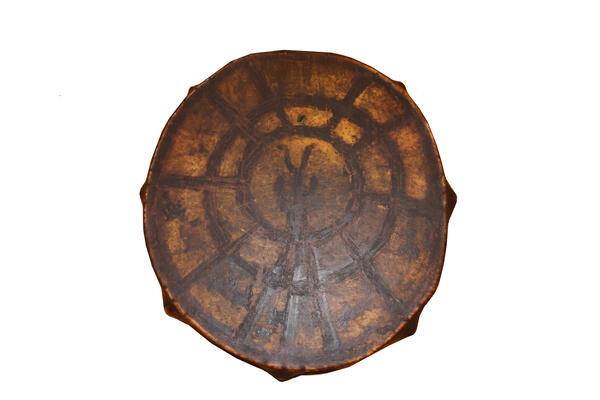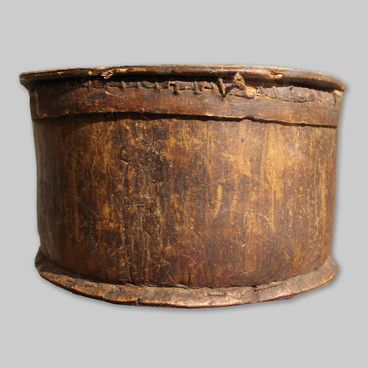The shaman’s tambourine is a wooden instrument covered with well-tanned leather. According to the observations of the ethnographer Glafira Vasilevich, the tambourines of the western Evenks were ovoid, and the tambourines of the eastern ones — round or only slightly ovoid. The instruments carried a multi-dimensional semantic load: they symbolized the Universe, were the receptacle of shamanic spirits-helpers and the spirit of the Supreme deity and mistress of the earth Enekan Buga.
The shaman used the tambourine during songs, dances and various rituals — for him it was a faithful companion and guide to other worlds. The tambourine was often a reflection of the shaman’s vital energy, so the safety of the instrument was carefully observed. It was believed that, if the tambourine breaks, the shaman could die. After the shaman’s death, his tambourine was cut up, like all other things, and placed on the grave. Throughout his life, a shaman could have more than one tambourine, only not simultaneously.
To manufacture this ritual tool, special wood was chosen — not every tree could be suitable for the service of the shaman, but only those chosen by the spirits. The shell, that is, the hoop of the tambourine, was made of cedar wood — specifically from the part of the trunk that was facing South. Along the hoop there were “ears” — according to the level of the shaman’s power. The stronger he is in spirit, the more ‘ears’ were on the tambourine. These resonant bumps on the hoop gave the instrument a slightly wavy outline and served as a symbolic representation of an animal fangs, which added strength to the shaman.
To cover the tambourines with buckskin, they used the veins located along the cervical spine of a deer or elk, from which strong threads were obtained. The crosspiece inside the tambourine was made of durable wood or metal.
Also, the tambourines were decorated with paintings which were applied with natural colors that have their own symbols. The most common image on the front side of the instrument was the universe and its division into the upper, middle and lower worlds. In other images — a tree with branches, on which cradles hang, symbolizing human life. The same tree, with its roots facing upwards, meant the other world.
To make the sound of the tambourine more powerful, during kamlaniy (rituals) — communication with spirits — the instrument was heated with the fire. This could be done either by the shaman himself or by his assistant.
The shaman used the tambourine during songs, dances and various rituals — for him it was a faithful companion and guide to other worlds. The tambourine was often a reflection of the shaman’s vital energy, so the safety of the instrument was carefully observed. It was believed that, if the tambourine breaks, the shaman could die. After the shaman’s death, his tambourine was cut up, like all other things, and placed on the grave. Throughout his life, a shaman could have more than one tambourine, only not simultaneously.
To manufacture this ritual tool, special wood was chosen — not every tree could be suitable for the service of the shaman, but only those chosen by the spirits. The shell, that is, the hoop of the tambourine, was made of cedar wood — specifically from the part of the trunk that was facing South. Along the hoop there were “ears” — according to the level of the shaman’s power. The stronger he is in spirit, the more ‘ears’ were on the tambourine. These resonant bumps on the hoop gave the instrument a slightly wavy outline and served as a symbolic representation of an animal fangs, which added strength to the shaman.
To cover the tambourines with buckskin, they used the veins located along the cervical spine of a deer or elk, from which strong threads were obtained. The crosspiece inside the tambourine was made of durable wood or metal.
Also, the tambourines were decorated with paintings which were applied with natural colors that have their own symbols. The most common image on the front side of the instrument was the universe and its division into the upper, middle and lower worlds. In other images — a tree with branches, on which cradles hang, symbolizing human life. The same tree, with its roots facing upwards, meant the other world.
To make the sound of the tambourine more powerful, during kamlaniy (rituals) — communication with spirits — the instrument was heated with the fire. This could be done either by the shaman himself or by his assistant.



